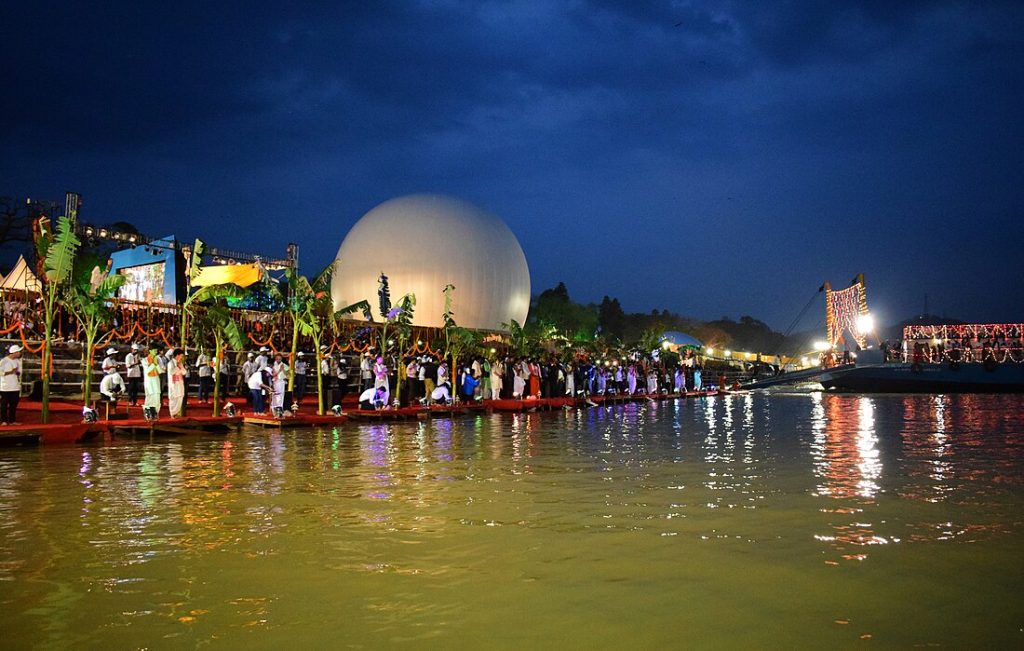Introduction
Namami Brahmaputra was an international festival organized to celebrate the beauty, cultural significance, and economic importance of the Brahmaputra River. Held in Assam, it was the first international river festival of its kind in the state. The event was conceptualized and organized by the Assam Government to promote tourism, showcase Assam’s rich cultural heritage, and highlight the importance of the Brahmaputra River in the socio-economic landscape of the region.
Inauguration and Duration

Namami Brahmaputra was celebrated from March 31 to April 4, 2017. The festival was inaugurated by the then President of India, Shri Pranab Mukherjee, in a grand ceremony attended by several dignitaries, including state and national leaders, diplomats, and cultural icons. The inauguration took place on the banks of the Brahmaputra in Guwahati, the state’s largest city and cultural hub.
Objectives of the Festival
The primary objectives of the festival were:
- To showcase Assam’s art, heritage, and culture on an international platform.
- To promote tourism and economic development through cultural exchange and business collaborations.
- To highlight the ecological significance of the Brahmaputra River and encourage conservation efforts.
- To strengthen regional and international cooperation by inviting participants from various countries.
Celebrations Across 21 Districts
One of the unique aspects of Namami Brahmaputra was its multi-location celebration. The festival was not confined to Guwahati but was hosted across 21 districts of Assam that are directly connected to the Brahmaputra River. These districts organized various events and activities, ensuring the widespread participation of local communities.
Key Highlights of the Festival
The five-day festival was filled with numerous activities that attracted visitors from across the country and abroad. Some of the key highlights included:
1. Cultural Performances and Traditional Music
The festival showcased Assam’s diverse cultural heritage through traditional dance and music performances. Folk dances such as Bihu, Sattriya, and Bagurumba were performed by renowned artists. Musical performances included Assamese folk songs, devotional music, and contemporary fusion bands.
2. Adventure Sports and River Activities
To celebrate the spirit of the Brahmaputra, various adventure sports and river activities were organized. These included boat races, kayaking, parasailing, and traditional fishing demonstrations. Adventure enthusiasts from different parts of India participated, adding to the excitement of the event.
3. Trade and Business Summits
Recognizing the economic potential of Assam, the festival hosted business and trade summits with the participation of national and international investors. Entrepreneurs, government officials, and business leaders discussed investment opportunities in Assam, particularly in sectors like tourism, agriculture, and river transport.
4. Food Festivals and Handicraft Exhibitions
The festival also featured food festivals and handicraft exhibitions, promoting local cuisine and traditional crafts. Assamese delicacies such as pithas (rice cakes), tenga (sour fish curry), and traditional meat preparations were served to visitors. The handicraft stalls displayed handwoven textiles, bamboo products, and pottery, providing a platform for artisans to showcase their skills.
5. Spiritual and Religious Ceremonies
A significant aspect of Namami Brahmaputra was its spiritual dimension. The river, considered sacred by many communities, was honored through traditional prayers, aarti (lamp-lighting ceremonies), and yajnas (ritual offerings). Monks, priests, and spiritual leaders from various faiths participated in the ceremonies, highlighting the river’s spiritual and cultural importance.
6. Film Screenings and Art Exhibitions
The festival also celebrated Assam’s contribution to the world of cinema and visual arts. Special film screenings were held, showcasing Assamese films and documentaries focused on the Brahmaputra River. Art exhibitions featured paintings, photographs, and sculptures inspired by the river and its surroundings.
Participation from International Delegations
Namami Brahmaputra had an international appeal, attracting participation from several countries. Delegations from Japan, China, Thailand, Vietnam, and Bhutan attended the festival, fostering cultural exchange and diplomatic relations. International artists, musicians, and business representatives also took part in various events.
Environmental Awareness and River Conservation
A key focus of the festival was to create awareness about the ecological challenges facing the Brahmaputra River. Seminars and panel discussions were held on topics such as river pollution, erosion, and sustainable development. Environmentalists and policymakers emphasized the need for river conservation efforts to ensure the Brahmaputra remains a vital lifeline for future generations.
Impact of Namami Brahmaputra
The festival had a lasting impact on Assam’s cultural and economic landscape. Some of the notable outcomes included:
- Increased tourism and international recognition for Assam.
- Greater awareness about the economic and ecological importance of the Brahmaputra River.
- Strengthened business relations and new investment opportunities.
- Revival and promotion of traditional art, music, and handicrafts.
- Enhanced infrastructure development in festival-hosting districts.
Conclusion
Namami Brahmaputra was a historic event that successfully celebrated Assam’s rich heritage, cultural diversity, and the significance of the Brahmaputra River. By blending cultural festivities with economic discussions and environmental awareness, the festival left a lasting impression on visitors and participants alike. It set a precedent for future large-scale cultural events in the region, reinforcing Assam’s position as a vibrant and dynamic state in India.
FAQ’s
Q. What is Namami Brahmaputra?
Namami Brahmaputra is an international river festival organized by the Assam Government to celebrate the cultural, economic, and environmental significance of the Brahmaputra River.
Q. When and where was Namami Brahmaputra held?
The festival was held from March 31 to April 4, 2017, across 21 districts of Assam, with the main event in Guwahati.
Q. Who inaugurated Namami Brahmaputra?
The festival was inaugurated by the then President of India, Shri Pranab Mukherjee.
Q. What were the main objectives of Namami Brahmaputra?
The objectives included promoting Assam’s art, heritage, tourism, economic opportunities, and environmental conservation.
Q. What were the key highlights of the festival?
Cultural performances, adventure sports, trade summits, food festivals, handicraft exhibitions, spiritual ceremonies, and international delegations were among the key attractions.




